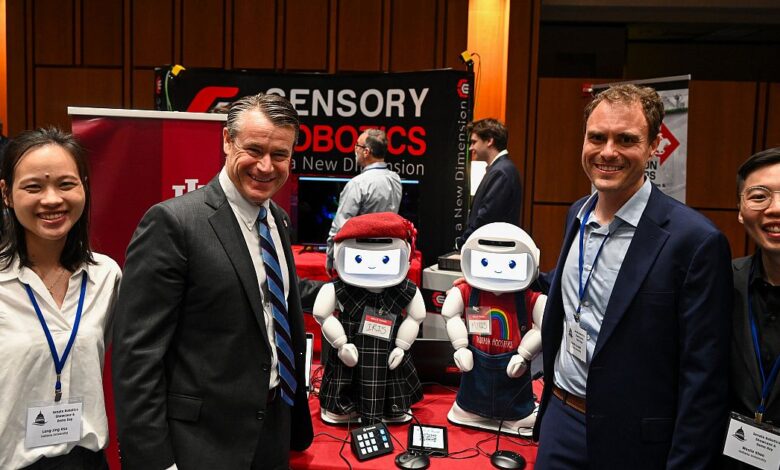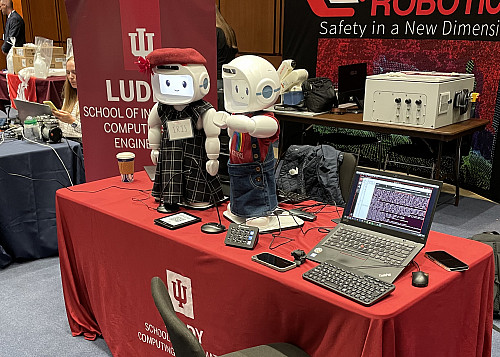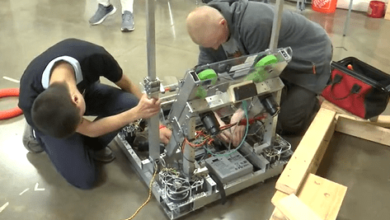Future of social robots showcased in IU researchers’ travels to D.C., abroad: IU News

Indiana University experts on artificial intelligence are traveling across the country — and across the globe — to conduct research and share knowledge about how the rapidly advancing field of AI could improve lives by powering the next generation of “social robots.”
On April 30, professor of computer science David Crandall, post-doctoral researcher Weslie Khoo and Ph.D. student Long-Jing Hsu, all of the IU Luddy School of Informatics, Computing and Engineering in Bloomington, traveled to Washington, D.C., to participate in the Senate Robotics Showcase and Demo Day. The event, which took place on Capitol Hill, was co-hosted by the Senate Artificial Intelligence Caucus. Members of the caucus include U.S. Sen. Todd Young, who was among those in attendance.
“This was a great opportunity for academic and industry experts from across the country to show the latest in AI and robotics technology to policymakers,” said Crandall, who is also director of the Luddy Artificial Intelligence Center in Bloomington. “It’s not often that you get invited to present your work at the U.S. Senate. We were honored.”
The event, which had strong representation from the private sector as well as academia, showcased how federal investment in research, workforce training and education have advanced robotics innovation in the United States. IU was one of only 40 exhibitors invited to participate.
At IU’s exhibit, Crandall said visitors such as Young and National Science Foundation Director Sethuraman Panchanathan interacted with IRIS, a “social robot” developed at IU. IRIS can engage in conversation thanks to a type of AI model known as a large language model, or LLM, and the researchers’ work to adapt it to in-person interaction.
In collaboration with the Toyota Research Institute, IU faculty and students designed and built IRIS to gain deeper understanding about how people, including adults with dementia, might benefit through interaction with robots.

Long-Jing Hsu, left, and David Crandall, center, speak with legislative staffers and leaders during the Senate Robotics Showcase and Demo Day. Photo by Brian Mosley, Computing Research Association
As part of this research, Hsu and Selma Šabanović, a professor of informatics at the IU Luddy School in Bloomington, are working in collaboration with Jill’s House, a local memory care facility, to observe older adults’ interactions with IRIS. They also work regularly with local senior citizens — including individuals at Jill’s House — to refine and develop IRIS’ conversational abilities, such as its ability to understand speech and to react to subtle social cues and facial expressions.
Hsu, Šabanović and others then apply these insights to program IRIS with a number of “skills.” These include general conversation, the ability to react to photographs and the ability to guide residents in a reflection activity, in which they are encouraged to discuss past events and future plans, Hsu said.
The conversations these skills draw from residents can be used to encourage actions that will deepen social bonds with friends and family, Šabanović said. For example, Hsu worked with Jan Bays, director of program development and education at Jill’s House, to organize a pie-tasting competition after one resident shared her love of pie with IRIS.
The research project’s overarching goal is to explore how robots can enhance people’s ikigai, a Japanese word that refers to one’s sense of meaning in life, as well as feeling of social purpose and everyday joy, Šabanović added.
“We’ve done research that shows the social norms around interacting with robots are very different in the United States and Japan,” she said. “But one thing people in both countries seem to agree on is that talking to a robot is often easier than talking to a person; there aren’t the same social norms or pressures since a robot doesn’t judge. It can draw people out in ways that might not occur as easily with an unfamiliar person.”

IU’s IRIS robots on display at the Senate Robotics Showcase and Demo Day. Photo courtesy of David Crandall
The initial research on people’s reactions to IRIS took place in collaboration with Shinichi Nagata, a former Ph.D. student at the IU School of Public Health-Bloomington who is now a professor at the University of Tsukuba in Japan. On May 13, Šabanović and Crandall will return to Japan to start a study at a nursing home near Toyoko similar to the research conducted at Jill’s House in Bloomington.
In addition, Crandall and Šabanović will travel to Geneva, Switzerland, to demonstrate their research with IRIS at the United Nations’ AI for Good Summit from May 30 to 31.
“One message we keep hearing over and over from caregivers is they really can envision a future in which robots could be integrated into memory care,” Šabanović said. “It’s not about taking the place of a caregiver, of course, but more about how robots may be able to help relieve some of the burden on caregivers — how they could become an increasingly acceptable tool to draw upon when you’re considering activities for older adults, with or without dementia.”
The co-hosts of the Robotics Showcase and Demo Day were the Computing Research Association, Carnegie Mellon University and the IEEE-USA, an organizational unit of the Institute of Electrical and Electronics Engineers that supports the interests of the organization’s U.S. members. The event was sponsored by the Task Force on American Innovation.



